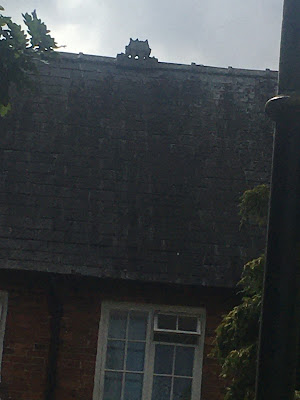A few weeks ago, I visited the pretty Lincolnshire village of Tattershall, primarily to visit the castle there. It was a beautiful summer day and rather bucolic in its way. Cows mooched about a river like a Constable painting, we sat in the sun eating sandwiches near the shade of the castle as a Spitfire flew round the village from one of the neighbouring air fields. At other times, Typhoons from another airbase launched with resounding booms and flew straight up into the clouds.
The castle itself is an interesting one. The original stone one being built without a keep in the pattern of Bolingbroke, birthplace of usurper king, Henry IV. However, a few kings later, by Henry VI’s time, it was home to Ralph Cromwell, his Lord High Treasurer (and quite a successful one, considering his time in office and the fact he ended it both alive and not in disgrace). To reflect his new power, he built a keep in Tattershall, but built it out of brick. It took thousands of bricks, shipped down through an altered river. As such it’s quite an impressive sight.The castle’s history becomes quite checkered with Cromwell not having any children (he’s not related to any of the more famous Cromwells). The castle was passed about and was actually besieged during the civil war, with cannonballs demolishing the older stone parts of the castle but bouncing off the brick one.
It was then left empty and the insides rotted out. It become a day out in the 18th and 19th century and the stairwells (which survived) were absolutely covered in graffiti - alas, no Merry-Thought style poems, just names and dates. In 1910, it was bought by Lord Curzon, who spent a great deal in doing it up and restoring the fireplaces, which had been sold to an American buyer. The fate of these fireplaces actually prompted improvements in legal protection to old buildings. He then gave it to the National Trust.
Near the Castle sits a large church. There was originally a large college around it, which was later dissolved. The church was started by Ralph Cromwell and looks huge, considering the small village it serves. It’s home to over a thousand bats, which flock around the cathedral at night, and even a little in the day. Everything in the church is covered up due to the batshit, which is everywhere. There aren’t only bats in the belfry, there are bats in every crevice. The church is also home to Tom Thumb’s gave.
Not a short person nicknamed Tom Thumb, but the actual fairy-tale figure of Tom Thumb. Reputedly 47cms tall and dying at the age of 101, his gravestone is one small paving slab. Nearby Lincoln Cathedral also used to have a Tom Thumb grave, but it has since gone missing - Tattershall’s is still there. It would seem that Lincolnshire really took the Tom Thumb story to heart. Interestingly, the date on the grave, 1620, is also about the time the character started appearing in chapbooks and the like. The town also claims to have Tom Thumb’s house, a small house-like structure on the top of a building in the market square.
It’s actually something called a louvre or louver, a 14th century architectural feature designed to let in air and light but not rain (or evil spirits). Apparently, it used to belong on a different building before it was on the one it is currently.
Now the eighteenth century bit…and it’s something of an mystery, or possibly just an odd coincidence. In scrobbling around on the net, reading about Tattershall, I didn’t see anyone making the connection.
One of Henry Fielding’s most successful dramatic works, before he turned magistrate and novelist, was The Tragedy of Tragedies. That play was, in itself, a reworked version of an earlier play, Tom Thumb. It tells a version of the Tom Thumb story, with him going to King Arthur’s court and killing giants and being given the hand of the princess, Huncamunca. He is later reported dead, but it’s actually a monkey before being killed by being eaten by a cow. His ghost returns and is then killed by a court member, then everyone kills each other. Apart from being an important part of his development as a playwright, the play caused Jonathan Swift to laugh, a man who was known for never laughing.
I said earlier, that Tattershall Castle was left empty. Villagers kept their cows in the downstairs parts, people painted watercolours of it and more daring visitors climbed the stairs in the decaying structure and carved their names in the walls. On the third floor, above an archway, carved deeply and neatly, is the name Henry Fielding. Was it that Henry Fielding? Did he take a trip to Tattershall, carve his name in the castle and visit the church? Did he see Tom Thumb’s minuscule grave and decide to write a play where the character dies three times? There’s no way of proving it, of course, but I’d like to think so.







No comments:
Post a Comment